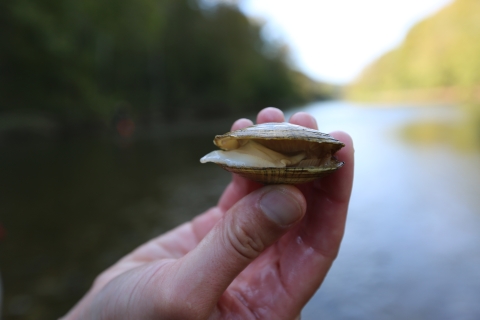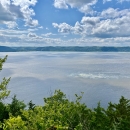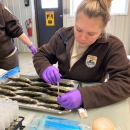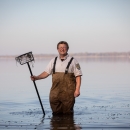States
Michigan, North Carolina, Ohio, Oregon, Virginia, Washington, WisconsinUnknown Cause of Mass Mortality Events in Mussels
Across the country, scenes of thousands of freshwater mussel shells scattered on the banks and bottoms of lakes and rivers haunts scientists. For the most part these mussel die-offs are unexplained and mysterious. Pollution and contaminants are a well known cause of mortalities but in the case of these die-offs there were no contaminants found. Unlike fish die-offs, mussel mass mortality events can be harder to find because the shells are often found under the surface of the water. Scientists are trying to better understand the scope of these events.
The Mussel Mortality Response Team
In partnership with other organizations, the Mussel Mortality Response Team is investigating pathogenic causes of these mortalities. The team is made up of UW–Madison, the U.S. Geological Survey Upper Midwest Environmental Sciences Center in La Crosse, and the U.S. Geological Survey National Wildlife Health Center in Madison. The team has been establishing a framework to study pathogens in mussels because, so little is known about it. So far, the team has identified over 600 novel viruses!
Why Does it matter?
Freshwater mussels are one of the most endangered species in the world. An estimated 70% of them are classified as being threatened or endangered. Mussels are incredible filterers of water and help keep water clean for humans, wildlife, fish, and anything else that needs clean water. They are known to filter out pharmaceuticals, personal care products, herbicides, flame retardants, E. coli, avian influenza, and reduce bacterial and nutrient loads. The ecosystems they are found in cannot afford to lose such an important organism. Identifying what is the cause of these mass mortalities is critical to the conservation of these species.
The team works on:
- Developing sampling protocol to search for etiological agents in mortality events.
- Collecting virology, bacteriology, metabolomic, and histological samples from various mussel mass mortality events across the country.
- Identifying novel viruses, several noteworthy bacteria, and novel parasites that appear to replace the developing eggs of the mussels.
- Developing diagnostic assays that can be used to quickly assess mussel mortality events for the presence of potential pathogens.
- Conducting in vivo trials where healthy mussels are exposed to microbes to assess pathogenicity.
Where the team has studied
We have studied mussel mortality events in Virginia, North Carolina, Wisconsin, Michigan, Ohio, Minnesota, Washington, and Oregon.
Mussel Mortality Response Team Roles
Jordan Richard and Tony Goldberg: Virology
Eric Leis and Sara Dziki: Bacteriology
Isaac Standish: Assay Development
Susan Knowles: Histology
Diane Waller: Malacologist
How can you help?
Please contact us with information on any historical or current freshwater mussel die-offs you’re aware. Feel free to reach out if you are conducting similar research and would like to collaborate.
Publications:
Joel G Putnam, John N Steiner, Jordan C Richard, Eric Leis, Tony L Goldberg, Christopher D Dunn, Rose Agbalog, Susan Knowles, Diane L Waller. 2023. Mussel mass mortality in the Clinch River, USA: metabolomics detects affected pathways and biomarkers of stress, Conservation Physiology 11: coad074,https://doi.org/10.1093/conphys/coad074
Richard, J.C., Blevins, E., Dunn, C.D., Leis, E.M., and Goldberg, T.L. 2023. Viruses of Freshwater Mussels during Mass Mortality Events in Oregon and Washington, USA. Viruses. 15: 1719. https://doi.org/10.3390/v15081719
Cone, David K, Appy, Ralph G., and Leis, Eric M. 2023. Gyrodactylus, Fundulotrema, and Salsuginus Species (Monogenea) Infecting Fundulus parvipinnis parvipinnis (Osteichthyes: Fundulidae) in Central and Southern California Estuaries and Bays. Bulletin, Southern California Academy of Sciences, 122(2):62-79
Knowles S, Dennis M, McElwain A, Leis E, Richard J. Pathology and infectious agents of unionid mussels: A primer for pathologists in disease surveillance and investigation of mortality events. Veterinary Pathology. 2023;0(0). doi:10.1177/03009858231171666
Tony L. Goldberg, Emilie Blevins, Eric M. Leis, Isaac F. Standish, Jordan C. Richard, Matthew R. Lueder, Regina Z. Cer, and Kimberly A. Bishop-Lilly. 2023. Plasticity, Paralogy, and Pseudogenization: Rhabdoviruses of Freshwater Mussels Elucidate Mechanisms of Viral Genome Diversification and the Evolution of the Finfish-Infecting Rhabdoviral Genera. Journal of Virology - online early
Eric M. Leis, Sara Dziki, Jordan Richard, Rose Agbalog, Diane Waller, Joel Putnam, Susan Knowles, Tony Goldberg. 2023. Further Bacteriological Analysis of Annual Pheasantshell (Actinonaias Pectorosa) Mussel Mortality Events in the Clinch River (Virginia/Tennessee), USA, Reveals a Consistent Association with Yokenella regensburgei. Freshwater Mollusk Biology and Conservation, 26(1), 1-10,
Richard, J.C.; Leis, E.M.; Dunn, C.D.; Harris, C.; Agbalog, R.E.; Campbell, L.J.; Knowles, S.;Waller, D.L.; Putnam, J.G.; Goldberg, T.L. Freshwater Mussels Show Elevated Viral Richness and Intensity during a Mortality Event. Viruses 2022, 14, 2603. https://doi.org/10.3390/v14122603
Leis, E.M.; Dziki, S.; Standish, I.; Waller, D.; Richard, J.; Weinzinger, J.; Harris, C.; Knowles, S.; Goldberg, T. A Bacteriological Comparison of the Hemolymph from Healthy and Moribund Unionid Mussel Populations in the Upper Midwestern U.S.A. Prompts the Development of Diagnostic Assays to Detect Yokenella regensburgei. Microorganisms 2023, 11, 1068.
Knowles, S., Leis, E.M., Richard, J.C., Cole, R., Agbalog, R.E., Putnam, J.G., Goldberg, T.L. and Waller, D.L. 2022. A Novel Gonadotropic Microsporidian Parasite (Microsporidium clinchi n. sp.) Infecting a Declining Population of Pheasantshell Mussels (Actinonaias pectorosa) (Unioinidae) from the Clinch River, USA. Parasitologia 2: 1–12. https://doi.org/1P0.3390/parasitologia2010001
Richard, Jordan C., Lewis J. Campbell, Eric M. Leis, Rose E. Agbalog, Chris D. Dunn, Diane L. Waller, Susan Knowles, Joel G. Putnam, and Tony L. Goldberg 2021. "Mussel Mass Mortality and the Microbiome: Evidence for Shifts in the Bacterial Microbiome of a Declining Freshwater Bivalve" Microorganisms 9, no. 9: 1976.
Jordan Richard, Eric Leis, Christopher D. Dunn, Rose Agbalog, Diane Waller, Susan Knowles, Joel Putnam, and Tony L. Goldberg. 2020. Mass morality in at-risk pheasantshell mussels (Actinonaias pectorosa) in the Clinch River, USA, linked to a novel densovirus. Scientific Reports 10:14498
Eric Leis, Sara Erickson, Diane Waller, Jordan Richards and Tony Goldberg. 2019. Culturable bacteria identified from the hemolymph of unionid mussels from the upper Mississippi River basin compared to Clinch River. Freshwater Mollusk Conservation and Biology 22:70-80
Tony Golberg, Christopher Dunn, Eric Leis and Diane Waller. 2019. A Novel Picorna-Like Virus in a Wabash Pigtoe(Fusconaia flava) from the upper Mississippi River, USA. Freshwater Mollusk Conservation and Biology 22:81-84
Eric Leis, Diane Waller, Susan Knowles, Tony Goldberg, Joel Putnam, Jordan Richard, Sara Erickson, Emilie Blevins and Jesse Weinzinger. 2018. Building a response network to investigate potential pathogens associated with Unionid mortality events. Ellipsaria 20(4): 44-45










